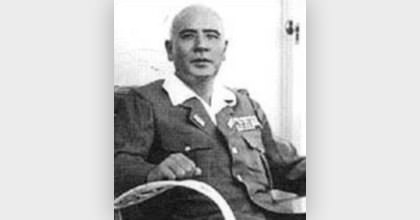Officer in command of the Japanese army that conquered the Philippines. Homma was born at Sado Island on November 27, 1889, into a family of privileged landowners. He graduated with high marks from the Japanese military academy and from the staff college. During World War I he was sent to France as an observer on assignment to the British command along the western front. In the 1920s he served as Japan’s resident army officer in India and later as military attaché in Great Britain. As head of the Japanese War Ministry’s press section, Homma defended the Japanese occupation of Manchuria in 1931 and eventually commanded troops in northern China. After the capture of Nanking (Nanjing) in 1937, he openly urged the need for a prompt peace in order to avert a calamity. He also doubted the ability of Tojo Hideki as a prospective war minister. Homma was commandant of the Formosa (now Taiwan) Army before his return to Japan in preparation for the outbreak of war.
Homma, whose avocations extended to the composition of plays and poetry, expressed an independent mind almost unheard of within the inflexible Japanese command structure. For example, in a fiery manner he questioned the particulars of his new assignment and had been audacious enough to declare publicly that hostilities with England and the United States would be an act of insanity. By December 1941 Homma, with the rank of lieutenant general, was the supreme commander of all Japanese army units scheduled to invade the Philippines. The Fourteenth Army, headquartered in Formosa, contained only two divisions, the 16th and the 48th, supported by service and logistical elements. Furthermore, the government’s timetable permitted use of the 48th Division for only fifty days, the period allotted for the Philippine campaign, because the unit was destined for employment in the Dutch East Indies (now Indonesia). Japanese strategy directed Homma to seize Manila, the capital; no preparation was made for a U.S. withdrawal into the Bataan Peninsula. On December 22, Homma put ashore the 48th Division at Lingayen Gulf and landed the 16th Division at Lamon Bay as wings meant to envelop Manila. Brushing aside resistance, his army raced for Manila but was delayed, despite its control of the air, at the Calumpit bridges while General Douglas MacArthur’s forces hastened to Bataan. Homma’s units eventually entered the city on January 2, 1942. However, to his disappointment, its capture failed to effect the archipelago’s surrender.
Behind schedule and deprived of the seasoned 48th Division, Homma engaged the Fil-American army in Bataan with the green 65th Division, newly arrived from Formosa. He felt a repeated sense of urgency to step up his attack, notwithstanding inferior numbers and stubborn resistance, because of General Yamashita Tomoyuki’s successful offensive in Malaya (now Malaysia). With the Fourteenth Army exhausted and the campaign stalled, Homma halted the offensive in early February and requested reinforcements. His soldiers were tired, diseased, and debilitated by wounds. By April his reinforced army, backed by airpower and artillery, renewed the attack and quickly forced the U.S. capitulation on Bataan. But head-quarters had underestimated the number of prisoners to be handled and to be encamped at sites on Luzon; consequently, Japanese logistics collapsed and the Bataan death march resulted. Homma, already off schedule, moved next against Corregidor. Becoming more jumpy and agitated because of demands from general headquarters, he waited anxiously for the assault on the island fortress. He visited the debarkation point of Lamao to see off the attackers, knowing that an operational failure would lead to his dishonor. His anger boiled on May 5 when General Jonathan Wainwright, commander of FilAmerican forces, declined to surrender all units in the islands—striking his clenched hands on a table, he threatened to keep fighting on Corregidor. Although Wainwright reconsidered and decided to surrender, Homma, greatly offended, told him to go back to Corregidor in order to capitulate to the Japanese officer at the scene.
Despite his victory, Homma was out of favor with the army general staff. His Philippines campaign had been too lengthy and expensive. Besides, there was displeasure with his forbearance toward the Filipino populace and his refusal to circulate anti-American propaganda. In late August he was ordered to Japan and placed on reserve. Following Tojo’s downfall in December 1943, Homma was selected as minister of information by the incoming Prime Minister, Kiso Kuniaki. In September 1945, to his astonishment as well as that of the Japanese public, he was arrested and indicted for war crimes by the Allies, charged with accountability for the Bataan death march in particular. He was found guilty on February 11, 1946, and sentenced to the by firing squad. Despite an eleventh-hour plea by his wife to General MacArthur, he was executed on April 3, 1946, in Manila.
Fujiko, wife of General Masaharu Homma who was on trial for war crimes in Manila, Philippines. The High Commissioner’s residence is in the background.
For a World War II Japanese general, Homma was an attractive personality, and his execution disturbed a number of Americans in the occupation forces. Many informed observers, at the time and since, have felt that he was executed primarily because he had defeated General MacArthur.
FURTHER READINGS Morton, Louis. The Fall of the Philippines (1953). Taylor, Lawrence. A Trial of Generals: Homma, Yamashita, MacArthur (1981). Toland, John. But Not in Shame: The Six Months After Pearl Harbor (1961). Whitman, John W. Bataan: Our Last Ditch (1990).
